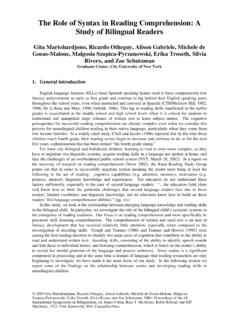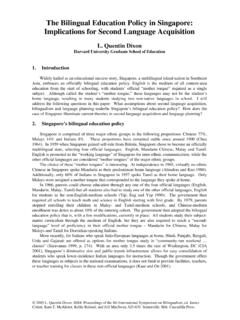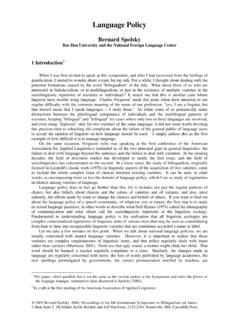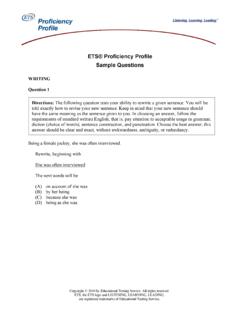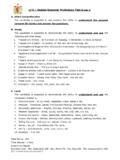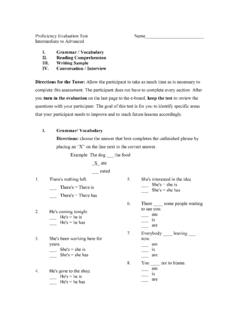Transcription of Current Language Proficiency Tests and Their …
1 Current Language Proficiency Tests and Their implications for preschool english Language Learners Alberto Esquinca, David Yaden and Robert Rueda University of Southern California 1. Introduction Formal assessment of children of all ages is becoming increasingly common for a number of reasons. One of the major reasons is the demand for schools to be accountable. The No Child Left Behind Act of 2001 includes accountability as one of its four main pillars, and stipulates that periodic testing is mechanism that will ensure that academic institutions are to show that children are making satisfactory progress. While some argue convincingly that the emphasis on accountability should be accompanied by a movement for greater equity in terms of the opportunities to learn to bring about significant and systemic changes (Gee, 2003), the drive for accountability is in place.
2 For better or worse, the movement toward closing the achievement gap is using widespread testing as a means to ensure its goal, and so children will be tested more often and at a younger age. Although preschool education has historically been a time in which children have an opportunity to socialize and prepare to transition into academic learning, the Current emphasis is on beginning schooling as early as possible. As standardized testing of preschoolers becomes more common, it remains important and to consider the developmental needs of very young children. The National Research Council (2001:237) states that some of the developmental considerations that should be taken when testing very young children include young children's inability to focus for extended periods of time, and Their limited capacity to be purposeful and intentional.
3 This means that in assessment situations, young children have a hard time attending to verbal instructions, situational cues and thus cannot be expected to complete test that school-aged children can. Furthermore, the No Child Left Behind Act also emphasizes learning english by means of english -Only instruction to the exclusion of other methods, including bilingual education or primary Language development and content skills (Rueda, in press). Thus english Language Learners will continue to be tested to ensure that they are making progress toward Their linguistic goals. As Vald s (2001) notes, english Language learning is often a priority over content learning. Because of the great emphasis on assessment, we must recall that all assessment should strive to adhere to the principles of reliability and validity (American Educational Research Association, American Psychological Association, and National Council on Measurement in Education, 1999).
4 Test developers often strive to meet these goals, however, despite Their best intentions, this goal is often not met. As Garcia and Pearson (1994) note, english Language learners often face a mainstreaming bias in formal testing, including a norming, content, cultural and linguistic biases. Because of these know biases, Harris Stefanakis (1998:11) recommends that formal assessment of linguistic minority students be scrutinized for interpretation bias, construct validity of test translations, cultural bias in test items, and particular children's test-taking experience. The starting point for the present research is the need to understand the basic characteristics of Language Proficiency Tests currently in use (the stated purpose of the Tests , and other basic information), the reliability and validity information available, and the criticisms that those Tests have received.
5 While we are aware of the alternatives to standardized Tests , we also know that, as August &. Hakuta (1997) note, Language Proficiency Tests cannot be ignored because they are tapping an ability correlated with a variety of Language proficiencies, not because they constitute Language Proficiency . (114). 2005 Alberto Esquinca, David Yaden, and Robert Rueda. ISB4: Proceedings of the 4th International Symposium on Bilingualism, ed. James Cohen, Kara T. McAlister, Kellie Rolstad, and Jeff MacSwan, 674-680. Somerville, MA: Cascadilla Press. The present paper constitutes the main findings from our search for the most appropriate assessments for english Language learners. We will discuss some of the most common assessments used, overview the features of those Tests , and discuss the most Current and relevant issues that affect preschool english Language learners.
6 2. Some commonly used instruments According to the most recent Survey of the States' Limited english Proficient Students and Available Educational Programs and Services 2000-01 (Kindler, 2002), school districts use a variety of methods to identify students as non-Enlish proficienty, place them in bilingual programs, and allow them to exit such programs (or reclassify them as english proficient). These methods include home Language use surveys, criterion-referenced Tests , achievement Tests , and Language Proficiency Tests . State Educational Agencies (SEAs) from the 50 states, the District of Columbia, Puerto Rico, Guam and the Northern Mariana Islands reported the use of Language Proficiency Tests in each state. According to that ranking, the five most common Language Proficiency Tests are the Language Assessment Scales (LAS), the IDEA Language Proficiency Tests (IPT), the Woodcock-Mu oz Language Survey, the Language Assessment Battery, and the Basic Inventory of Natural Language .
7 Common characteristics across instruments. An examination of these measures reveals that the most used Language Proficiency Tests are meant for school aged children. Because Tests for prekindergarten children are not reported in the Current survey our best guess as to what Language Proficiency Tests are used with preschoolers are that (a). school districts continue to use assessments like the Pre-LAS, the Pre-IPT, and the Woodcock-Mu oz as the 1995 survey indicated (Mac as, 1995) or (b) the above Tests , meant for school-aged children, are inappropriately used with Upon closer examination, we see that the four most-often used Tests , the LAS, the IPT, the Woodcock-Mu oz, and the LAB share a number of features. The stated purpose for three of those Tests is strikingly similar. With the exception of the Woodcock-Mu oz, the Tests are designed to measure Language skills (speaking, listening, reading, writing) and discrete aspects of Language , , lexicon, phonology, syntax.
8 Table 2 gives details about some of the main characteristics of the four most commonly-used Tests . As Table 2 also shows, these Language Proficiency Tests are part of a long tradition of Language testing. Bachman's (2000) review of the literature on Language Tests outlines the development of Language testing over the last 20 years. He points out that while testing practice from the mid-1960s and the 1970s tended to be based on a construction of Language as skills (listening, speaking, reading, writing) and components (grammar, vocabulary, pronunciation), such constructions were critiqued as new approaches to the study of Language emerged. Specifically, in the 1980s, the influence of communicative approaches to Language instruction was paramount. Since applied linguists were developing approaches to teaching that focused on the co-construction of meaning, and the importance of context-based communication, traditional assessments (such as those developed in the 1970s) were ill-suited for the new approach.
9 In the 1990s, test-makers became concerned with issues such as the development of (a) new research methodologies, such as criterion-referenced measurement, (b). practical advances, such as pragmatics testing, (c) factors that affect test performance, (d) authentic and performance assessment, and (e) ethical considerations of Language testing. 1. Test representatives do not have information or do not respond to inquiries about this kind of test misuse (personal communication). 675 . Table 2: Four most commonly-used Language assessments Test Purpose Domains measured Grades/ Items Ages LAS Designed to measure those LAS Oral: vocabulary, listening 1-6 Vocabulary: english and Language skills comprehension, story-retelling, Name that necessary for functioning in LAS Rdg/Wrtng: mechanics picture nouns mainstream academic and usage, vocabulary, fluency, (desk, chair).
10 Environments. reading comprehension, Action words . sentence completion, essay (eating, laughing). writing. IPT To assist in the initial Vocabulary, comprehension, PreK-12 Vocabulary items identification, designation, syntax, and verbal expression. include and redesignation of a identification of student as being non- english nouns Speaking, Limited english (helicopter, speaking or Fluent english stove) and action Speaking. verbs (singing). WMLS Designed for measuring Verbal analogies, picture 4-adult Vocabulary part cognitive-academic Language vocabulary, letter-word Tests over proficiencies. identification, dictation classroom- specific items. Verbal analogies consists of items such as: sky . blue; tree . LAB "Designed to assess reading, Listening, speaking, reading, Level 1: N/A. writing, listening writing K-2. comprehension and speaking in english and Spanish.
